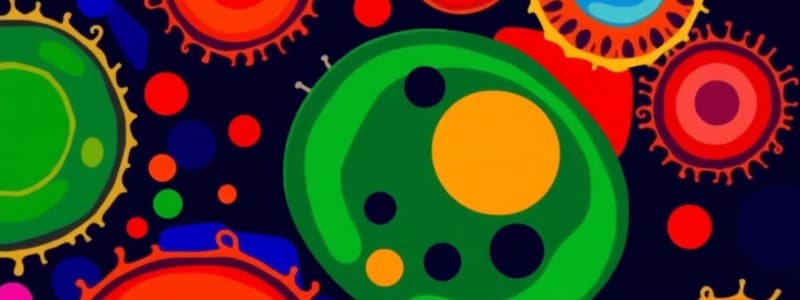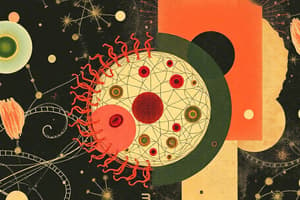Podcast
Questions and Answers
What is the primary function of the nucleolus within the nucleus?
What is the primary function of the nucleolus within the nucleus?
- Storage of genetic material
- Synthesis of lipid molecules
- Regulation of cellular temperature
- Site of RNA transcription and ribosome assembly (correct)
Which component of the cytoskeleton provides structural support and a framework for organelles?
Which component of the cytoskeleton provides structural support and a framework for organelles?
- Microtubules (correct)
- Microfilaments
- Ribosomes
- Intermediate filaments
What characteristic of the inner mitochondrial membrane is important for its function?
What characteristic of the inner mitochondrial membrane is important for its function?
- Contains ribosomes
- Relatively porous
- Selectively permeable (correct)
- Absorbs nutrients
How does glycolysis contribute to cellular metabolism?
How does glycolysis contribute to cellular metabolism?
What distinguishes the outer mitochondrial membrane from the inner mitochondrial membrane?
What distinguishes the outer mitochondrial membrane from the inner mitochondrial membrane?
Which organelle is described as the largest within a cell and surrounded by a nuclear envelope?
Which organelle is described as the largest within a cell and surrounded by a nuclear envelope?
What role do glucose transporters play in cellular metabolism?
What role do glucose transporters play in cellular metabolism?
Where does the process of ribosome assembly begin and complete?
Where does the process of ribosome assembly begin and complete?
Which nucleotide is unique to RNA and not found in DNA?
Which nucleotide is unique to RNA and not found in DNA?
What role does the lin-4 microRNA play in relation to lin-14?
What role does the lin-4 microRNA play in relation to lin-14?
Which of the following statements about protein synthesis is true?
Which of the following statements about protein synthesis is true?
What is the primary function of ATP in cellular processes?
What is the primary function of ATP in cellular processes?
What significant discovery did Ambros make about the lin-4 gene?
What significant discovery did Ambros make about the lin-4 gene?
What consequence can result from hyperuricemia in the body?
What consequence can result from hyperuricemia in the body?
Which of the following is a key role of microRNA in multicellular organisms?
Which of the following is a key role of microRNA in multicellular organisms?
What important function does ATP synthase perform in cells?
What important function does ATP synthase perform in cells?
What is the net gain of ATP molecules during glycolysis for each molecule of glucose?
What is the net gain of ATP molecules during glycolysis for each molecule of glucose?
At what concentration of ADP is the enzyme activity increased during the preparatory stage of glycolysis?
At what concentration of ADP is the enzyme activity increased during the preparatory stage of glycolysis?
Which products are generated from one molecule of glucose during glycolysis?
Which products are generated from one molecule of glucose during glycolysis?
What happens to NAD+ during glycolysis?
What happens to NAD+ during glycolysis?
Where does glycolysis primarily occur within a cell?
Where does glycolysis primarily occur within a cell?
What effect does oxygen availability have on glycolysis in certain cells?
What effect does oxygen availability have on glycolysis in certain cells?
What is the primary outcome of the conversion of pyruvate to lactate under anaerobic conditions?
What is the primary outcome of the conversion of pyruvate to lactate under anaerobic conditions?
Which of the following statements is true about the energy-releasing phase of glycolysis?
Which of the following statements is true about the energy-releasing phase of glycolysis?
What is the primary function of GLUT1?
What is the primary function of GLUT1?
What happens to pyruvate during aerobic glycolysis?
What happens to pyruvate during aerobic glycolysis?
Which glucose transporter has a low affinity but high capacity?
Which glucose transporter has a low affinity but high capacity?
In which tissues is GLUT3 primarily expressed?
In which tissues is GLUT3 primarily expressed?
What syndrome is associated with GLUT1 deficiency?
What syndrome is associated with GLUT1 deficiency?
How does GLUT4 respond to insulin?
How does GLUT4 respond to insulin?
What role does GLUT2 play in glucose metabolism?
What role does GLUT2 play in glucose metabolism?
Which GLUT transporter is primarily responsible for regulating insulin secretion?
Which GLUT transporter is primarily responsible for regulating insulin secretion?
Which cells do not depend on insulin for glucose uptake?
Which cells do not depend on insulin for glucose uptake?
What is the primary function of GLUT5?
What is the primary function of GLUT5?
How is the glycemic index (GI) calculated?
How is the glycemic index (GI) calculated?
Which of the following foods has a glycemic index higher than glucose?
Which of the following foods has a glycemic index higher than glucose?
What happens to GLUT4 in response to insulin?
What happens to GLUT4 in response to insulin?
Which statement about the glycemic index is true?
Which statement about the glycemic index is true?
Which cells express GLUT4?
Which cells express GLUT4?
When measuring the glycemic index, how long after eating is blood glucose typically monitored?
When measuring the glycemic index, how long after eating is blood glucose typically monitored?
Flashcards are hidden until you start studying
Study Notes
Cell Components
- Cytoplasmic Matrix: Provides structural support and a framework for cell organelles.
- Cytoskeleton:
- Composed of Microtubules, Intermediate Filaments, and Microfilaments.
- Facilitates intercellular communication.
- Mitochondrion:
- Contains two membranes:
- Outer membrane: Porous
- Inner membrane: Selectively permeable, and site of the electron transport chain.
- Contains two membranes:
- Nucleus:
- Largest organelle.
- Surrounded by the nuclear envelope.
- Contains DNA, forming the cell genome (entire set of genetic information).
- Nucleolus:
- Site of RNA transcription and ribosome assembly/synthesis, starting in the nucleus and completing in the cytoplasm.
- Nucleic Acids:
- DNA and RNA.
- Composed of adenine, guanine, and cytosine, with uracil only found in RNA and thymine only found in DNA.
- DNA is double stranded with complementary base pairing.
- RNA is single stranded, capable of folding to create complex secondary structures.
Protein Synthesis
- Ribosomes link amino acids together to form proteins.
Biological Energy
- ATP: Major energy storage form in cells.
- ATP synthase:
- Protein that catalyzes ATP formation using ADP and inorganic phosphate.
- Generates two molecules of ATP and two molecules of NADH.
Glucose Metabolism
- Complete glucose oxidation:
- Formula: Glucose + 6O2 = 6 CO2 + H2O
- Releases -2840 kJ/mol of free energy.
- Glycolysis:
- Takes place in the cytosol.
- Formula: Glucose + 2NAD+ = 2Pyruvate + 2NADH + 2H+
- Releases -146 kJ/mol of free energy (5.2% of total energy from glucose oxidation).
- Essential for tissues like the brain and cells with limited oxygen access.
- Generates lactate and ATP under anaerobic conditions.
Stages of Glycolysis
- Stage 1 (Reactions 1-5):
- Preparatory phase involving phosphorylation of glucose, conversion to fructose, re-phosphorylation, and cleavage into two glyceraldehyde-3-phosphate molecules.
- Requires an investment of 2 ATP molecules.
- Stage 2 (Reactions 6-10):
- Conversion of two glyceraldehyde-3-phosphate molecules to pyruvate, generating four ATP molecules and two NADH molecules.
- Results in a net gain of two ATP molecules per glucose molecule.
Membrane Transporters of Glucose
- GLUT1:
- Most ubiquitously expressed transporter.
- Responsible for glucose transport across the blood-brain barrier and supply to the developing central nervous system.
- Essential for erythrocytes, brain endothelial cells, and fetal tissue.
- Deficiency leads to GLUT1 deficiency syndrome, characterized by seizures due to insufficient brain glucose.
- GLUT2:
- Low-affinity, high-capacity transporter.
- Predominant expression in pancreatic β-cells, liver, small intestine, and kidneys.
- Transports monosaccharides from enterocytes into the portal blood.
- Involved in insulin release from β-cells in response to blood glucose levels.
- GLUT3:
- High-affinity transporter.
- Primarily expressed in glucose-dependent tissues, such as the brain and neurons as well as spermatozoa, placenta, and preimplantation embryos.
- Potential dysregulation could lead to glucose deficits in the brain and associated with dyslexia.
- GLUT4:
- Primary transporter for insulin-regulated glucose uptake in muscle and adipose tissue.
- Absence in other tissues renders them independent of insulin for glucose uptake.
- Insulin promotes translocation of GLUT4 from intracellular storage to the plasma membrane.
- GLUT5:
- Highly specific for fructose.
- Expressed in the small intestine, kidneys, brain, muscles, and adipose tissue.
- Primarily responsible for fructose transport across enterocyte brush border membranes.
Glycemic Index
- Measures the rate at which a particular food raises blood glucose levels.
- Calculated by comparing the area under the blood glucose curve after consuming the food with the area under the curve for a reference food (either glucose or white bread).
- Foods with a high glycemic index cause rapid and significant spikes in blood glucose, while foods with a low glycemic index cause slower and more gradual rises.
- Factors influencing Glycemic Index:
- Type of carbohydrate: Simple sugars have a higher GI than complex carbohydrates.
- Processing of food: Processed foods have a higher GI than unprocessed or minimally processed foods.
- Cooking methods: Boiling or steaming vegetables lowers GI compared with frying.
- Fat content: Adding fat can lower the GI.
- Fiber content: Foods high in fiber have a lower GI.
- Amount of food: Consuming a larger amount of food will increase the GI.
- Individual factors: Factors like age, fitness levels, and genetics can affect GI.
Studying That Suits You
Use AI to generate personalized quizzes and flashcards to suit your learning preferences.




